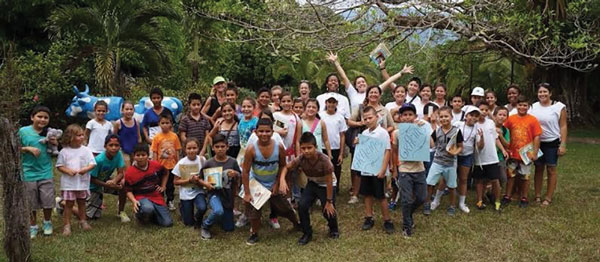KSTR Kid’s Camp
By Tammy Bushby, Volunteer
In March 2015 Kids Saving the Rainforest launched their monthly kid’s camp. Kids from throughout Quepos/Manuel Antonio and surrounding areas participated in an educational day about conservation and animal welfare. Throughout the day the kids took part in activities developed to teach them the importance of the local biodiversity in the forest and how they can help with the conservation of their local area.
The day was also about getting an introduction to some of the animals native to their country as well as some foreign ones. They were given a tour of the KSTR sanctuary and animal clinic which is the temporary home of some soon to be released rehabilitated wildlife, as well as some permanent members which unfortunately cannot be released into the wild for reasons such as injury or inability to cope in the wild.
Some of what they learned was important not just for the kids to know but also important for the older generations to understand as well. Simple concepts and information were taught which the kids took back to their families so that the knowledge spread further than just camp participants.
Kids Saving The Rainforest has six types of monkeys: Titi, White Faced, Spider and Howler, plus Tamarins and Marmosets. Costa Rica is a country that has many native monkey species and it has been portrayed for generations that monkeys love to eat bananas. This, in fact, could be an untruth propagated by the tourist industry to portray these creatures as humble and simplistic, which of course is untrue. All species of monkeys, from howlers to tiny squirrel monkeys, have very complicated social structures, innate understandings of their surroundings, and very successful mutualism with the ecosystem of which they are a large part.
When foraging for food they will, unlike the glutinous tourist at a buffet of the western world, feed on a variety of plant species and only for short periods of time. This ensures that they do not kill the source or cause it stress which can trigger a secondary metabolite response that may cause it to become toxic to the monkey.
While foraging they may indeed be a primary instigator of seed transportation and pollination of certain species.
With this in mind it’s important not to engage with wild monkeys as we can upset this balance. Feeding of wild species can upset the metabolism of the monkeys as well as interfere with their natural instincts and foraging habits. Monkeys are very susceptible to all illnesses and aliments that we humans carry, so coming into contact with them can be very detrimental to them as we can transfer illness and disease.
As I witnessed these children being educated along with their parents and guardians it was easy to see the information sinking in and see their empathy with and understanding of their environment grow and blossom.
Being part of the era that has been the instigator of deforestation, animal cruelty and a perpetually wasteful society that is modern times, it is our responsibility to educate the next generation about preventative measures and help fix the mistakes that we made so future generations can enjoy the beauty and wonder that is our natural world and also have a better understanding of our impact as well as where we stand in the world as a species.
So for a conservation group that was founded on the dreams and hopes of two young girls when they were nine years old, 16 years ago, it is a refreshing and inspirational sight to see kids being involved in Kids Saving The Rainforest!


